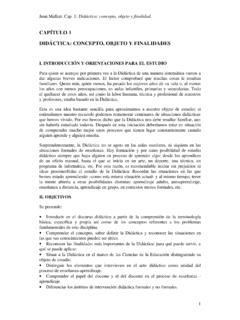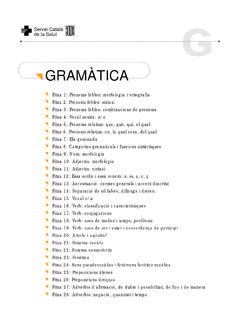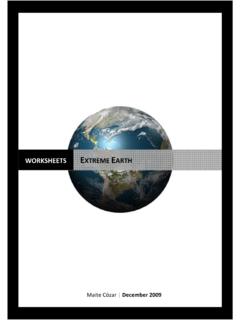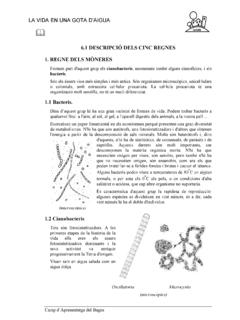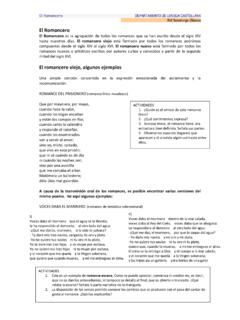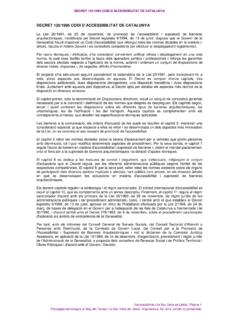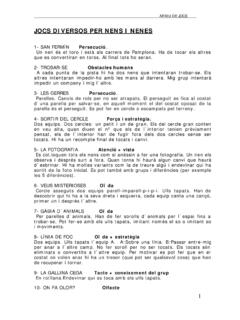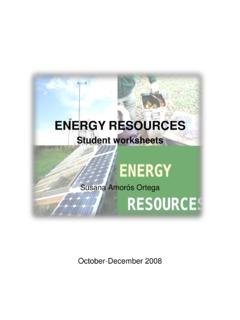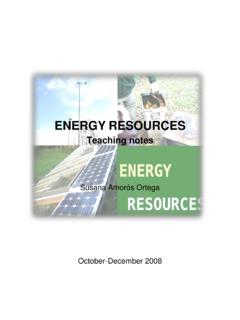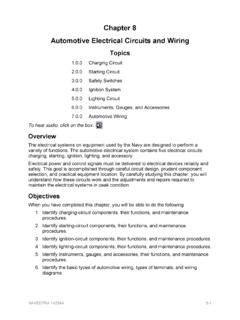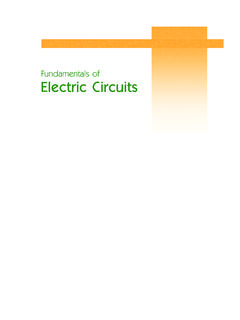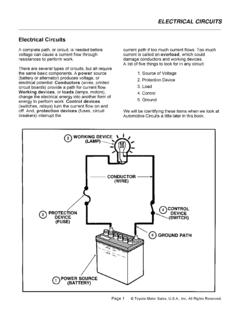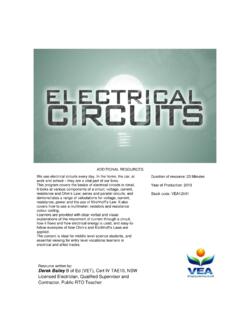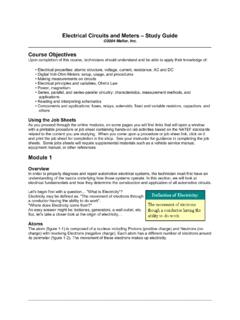Transcription of Electric Circuits & Application of Electrical Energy
1 Electric Circuits & Application of Electrical Energy Technology Bel n Gallego Electric Circuits & Application of Electrical Energy Technology Bel n Gallego Work in groups of three or four. Look at these pictures and discuss: ConsoleDVD playerMobileHairdryerCD playerTelevisionHeaterWashbasinOvenConso leMp3 MobileHeaterWashbasinComputerAlarm clockBreadCd-cassetteplayerToothbrush which of these objects do you use every day? Write down the names. which of them need electricity to work? why is electricity important in our lives? Electric Circuits & Application of Electrical Energy Technology Bel n Gallego Look at the picture. Make 5 sentences that explain the behaviour of the particles of the atom.
2 Complete these sentences with the most suitable word. Work in pairs. ) _____ (electrons/protons) have negative charge and protons have _____ (positive/negative) charge. ) A _____ (stable/charged) atom has the same number of electrons and protons. ) If an atom has a higher number of electrons than of protons it is _____ (positively/negatively) charged. ) If an atom has a lower number of electrons than of protons it is _____ (positively/negatively) charged. ) If an atom is stable it _____ (has/does not have) charge. move don t move around the are Electrons Protons Neutrons aren t together in the nucleus Electric Circuits & Application of Electrical Energy Technology Bel n Gallego Look at this picture.
3 Where do you think there are more electrons? Now try to imagine what will happen. Choose the sentence you think is true. Electrons will move from negatively charged material to positively charged material Nothing. Electrons will move from positively charged material to negatively charged material. Now you know what electricity is. Write the definition. Your classmate has half of the words you need to complete the definition. Words: a, flow, electrons, in (Words of the other student: is, substance, a, of) - - - - - - - - - - - - - - - - - - - - - - - - - - - - - - - - Positively Charged Material Negatively Charged Material Conductor MaterialElectric Circuits & Application of Electrical Energy Technology Bel n Gallego Is it true?
4 Is it false? Put a True False Electrons move around the nucleus A negatively charged atom has positive charge A positively charged atom has more electrons than protons Stable atoms have the same number of electrons and protons Atoms are made of molecules Electrons move from negatively charged material to positively charged material Correct the false sentence. Write down the correction. Electric Circuits & Application of Electrical Energy Technology Bel n Gallego Look at the picture of the exercise 1. Which of those Electric devices need to be plugged in to work? Which of them need a cell or a battery to work? What is the way of electricity? Look at the picture. Electric gridPlugTelevisionPower ElectricStation To be plugged in Cell/Battery Electric Circuits & Application of Electrical Energy Technology Bel n Gallego Now, work in pairs.
5 Put the following sentences in order. a. Plugs are connected to an Electric grid b. An Electric grid carries the electricity produced in Power Electric stations. c. Electricity is produced in Power Electric Stations. d. Televisions must be plugged in to work e. Televisions need electricity to work. Write the sentences in the correct order. you know who invented the first bulb? Read the text below. Thomas Alva Edison was born in Ohio (United States) in 1847. He worked in business but he was also an inventor. He enjoyed doing experiments with electricity. In 1879 he invented the bulb. He used a carbonized bamboo filament. That bulb worked for 48 hours. He died in 1931. Where and when was he born?
6 What was his job? What did he invent? Which materials did he use? Thomas Alva Edison and his bulb Electric Circuits & Application of Electrical Energy Technology Bel n Gallego Look at these pictures. What do these Circuits have in common? Discuss in pairs and choose the most suitable sentence. These Circuits are all open. These Circuits are all closed. There are some elements running in the circuit ( : water, electrons). There are no elements running in the circuit . The circuit is interrupted. The circuit is not interrupted Now, write the sentences you have chosen. + ) Electric Circuits & Application of Electrical Energy Technology Bel n Gallego 2.) Which elements from both pictures do you think have the same function?
7 Match pairs. Below are parts of the definition of an Electric circuit . Can you put them in the correct order? An .. 4.) Discuss with your partner and answer: Which of the Electric elements of exercise 2 do you think give electrons Energy to move? Which of the Electric elements above do you think allows electrons to travel through it? Which of the Electric elements above do you think transform Electrical Energy into another kind of Energy ? of electrons. is a group of elements inter)connected to give way Electric Circuits & Application of Electrical Energy Technology Bel n Gallego We will do some experiments with Electric Circuits . We will start with the simplest. Before you start, you need to know: 1) Scientists and electricians draw Electric Circuits using international special symbols.
8 2) Electric circuit diagram: is a schematic drawing that represents an Electric circuit . For example: 3) Basic elements: BulbWireCellSymbolNamePictureElectric Components Electric Circuits & Application of Electrical Energy Technology Bel n Gallego EXPERIMENT 1 Material: 1 cell 1,5 V wires 1 bulb 1,5 V Picture What s happened? does not light up. The bulb ) lights up. Electric diagram You must change the picture for the symbol. EXPERIMENT 2 Material: 1 cell 1,5 V wires 1 bulb 1,5 V Picture What s happened? does not light up. The bulb ) lights up. Electric diagram You must change the picture for the symbol. + - + - Electric Circuits & Application of Electrical Energy Technology Bel n Gallego Conclusions: the first experiment the same terminal ) lights up.
9 In the second experiment if I connect the wire in different terminals of the cell the bulb doesn t light up. Write the correct sentence for every experiment. EXPERIMENT 3 Material: 1 cell 1,5 V wires 1 bulb 1,5 V Materials: paper, nail, rubber, pen. Picture What s happened? Put a It lights up It does not light up + - Material Electric Circuits & Application of Electrical Energy Technology Bel n Gallego Conclusions: Write the sentences for every experiment. paper a rubber doesn t lights up a nail When I connect the wires with a pen the bulb ) light up. Electric Circuits & Application of Electrical Energy Technology Bel n Gallego Remember the results of experiments in lesson 2.
10 Complete the chart. Materials that make a bulb light up Materials that do not make a bulb light up Re)order the letters of these words and complete the next sentences. RDONUCTOC= NAULTISRO= ) _____ is a material that allows electrons to pass through it. ) _____is a material that does not allow electrons to pass through it. Draw arrows () to show the direction of electrons in every case. Real way Conventional way Direct Current Alternating Current + ) + ) Electric Circuits & Application of Electrical Energy Technology Bel n Gallego Look at these pictures. Answer the questions below: ) Which of these devices have the same function? ) Which of these devices have an Electric circuit ?
